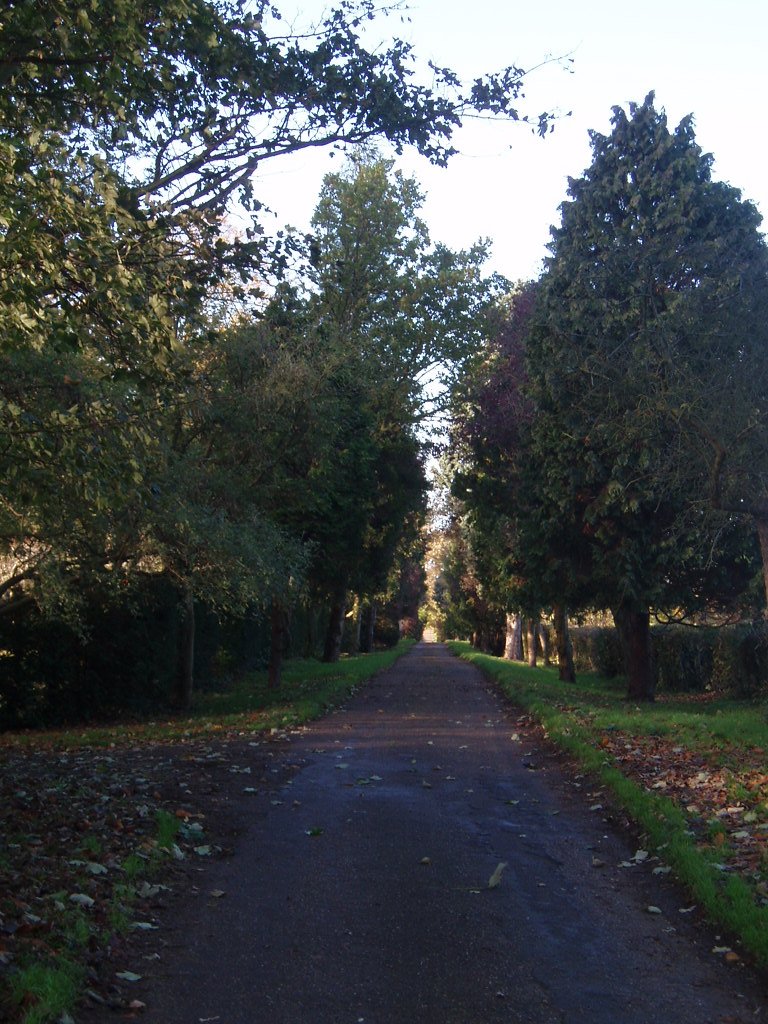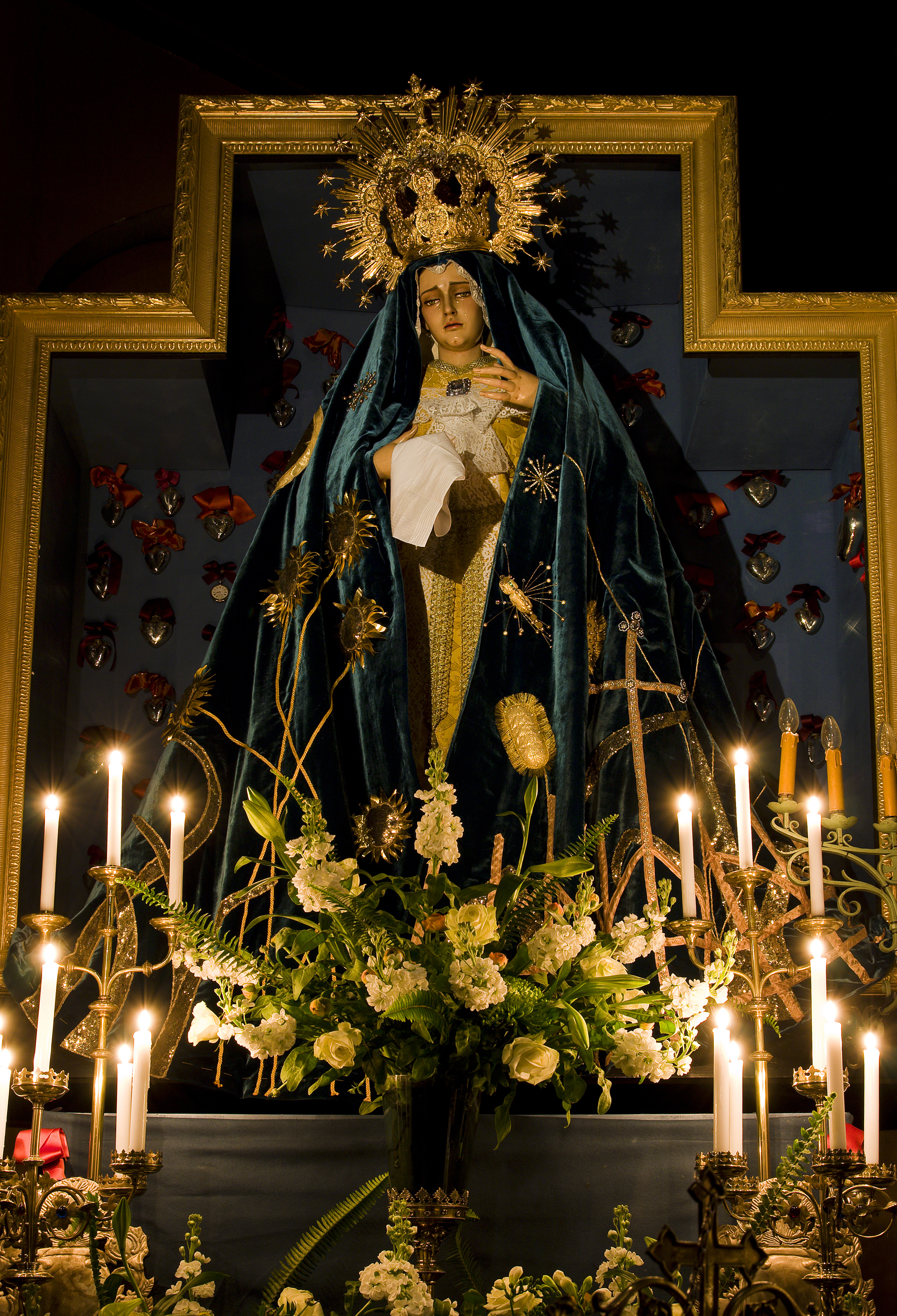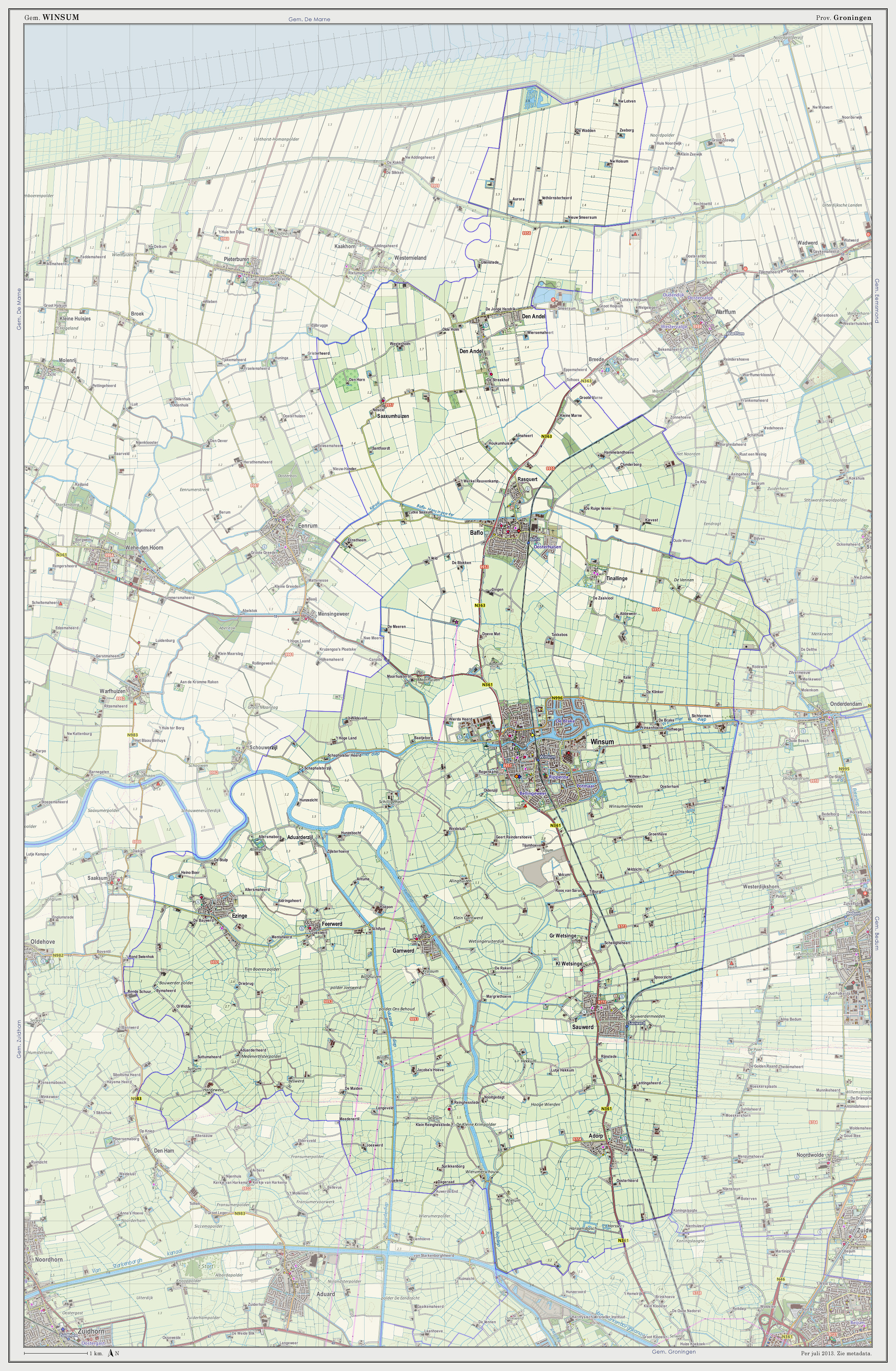|
Wehe-den Hoorn
Wehe-Den Hoorn (Gronings: ''t Hörn-Wij'') is a village in the Dutch province of Groningen. It is part of the municipality of Het Hogeland. It is a 1966 merger of the villages of Wehe and Den Hoorn. History Wehe was a ''terp'' (artificial mount) village on the road from Ulrum to Winsum. It was first mentioned in the 10th or 11th century as UUie and means temple (similar to Wye in Kent). Den Hoorn was a nearby hamlet. A part of the population remained Roman Catholic. Each year, several processions start in Wehe-den Hoorn to the Sorrowful Mother of Warfhuizen. The Dutch Reformed Church dates from 1553. The Catholic Saint Boniface Church dates from 1927. It was designed by Joseph Cuypers and his son Pierre Cuypers, and has a Mary statue from the 16th century. In 1679, the estate Borgweer was built near Wehe. Later it became the property of the family who renamed it Starkenborgh. It was torn down in 1832, and only a path remained which used to be a long driveway to the estate. ... [...More Info...] [...Related Items...] OR: [Wikipedia] [Google] [Baidu] |
Village
A village is a clustered human settlement or community, larger than a hamlet but smaller than a town (although the word is often used to describe both hamlets and smaller towns), with a population typically ranging from a few hundred to a few thousand. Though villages are often located in rural areas, the term urban village is also applied to certain urban neighborhoods. Villages are normally permanent, with fixed dwellings; however, transient villages can occur. Further, the dwellings of a village are fairly close to one another, not scattered broadly over the landscape, as a dispersed settlement. In the past, villages were a usual form of community for societies that practice subsistence agriculture, and also for some non-agricultural societies. In Great Britain, a hamlet earned the right to be called a village when it built a church. [...More Info...] [...Related Items...] OR: [Wikipedia] [Google] [Baidu] |
Ulrum
Ulrum () is a village in the Dutch province of Groningen. It is located in the municipality of Het Hogeland. History The first time the town was named was as ''Uluringhem'' in the 11th century. Ulrum is sited on two mounds. On the western one stands the Romano-Gothic church of Ulrum (built at the end of the 12th century), on the eastern mound stood the Asingaborg. Ulrum was once a thriving village with many tradesmen and small businesses. Now only agricultural activity remains. Ulrum was a separate municipality until 1990, when it merged with Eenrum, Kloosterburen, and Leens Leens is a village in the Dutch province of Groningen. It is located in the municipality of Het Hogeland. Leens was a separate municipality until 1990, when it was merged with Ulrum, Eenrum and Kloosterburen. Brief history Leens is located on ol .... The new municipality was called Ulrum at first, but was renamed to De Marne in 1992. Gallery File:De Houw - boerderij De Houw.jpg, Farm in Ulrum File:U ... [...More Info...] [...Related Items...] OR: [Wikipedia] [Google] [Baidu] |
Driveway
A driveway (also called ''drive'' in UK English) is a type of private road for local access to one or a small group of structures, and is owned and maintained by an individual or group. Driveways rarely have traffic lights, but some that bear heavy traffic, especially those leading to commercial businesses and parks, do. Driveways may be decorative in ways that public roads cannot, because of their lighter traffic and the willingness of owners to invest in their construction. Driveways are not resurfaced, snow blown or otherwise maintained by governments. They are generally designed to conform to the architecture of connected houses or other buildings. Some of the materials that can be used for driveways include concrete, decorative brick, cobblestone, block paving, asphalt, gravel, decomposed granite, and surrounded with grass or other ground-cover plants. Driveways are commonly used as paths to private garages, carports, or houses. On large estates, a driveway may be the ... [...More Info...] [...Related Items...] OR: [Wikipedia] [Google] [Baidu] |
Joseph Cuypers
Josephus Theodorus Joannes Cuypers (10 June 1861, Roermond - 20 January 1949, Meerssen) was a Dutch architect; primarily known for his Catholic churches. Life and work He was born to the architect, Pierre Cuypers, and his wife, Antoinette née Alberdingk Thijm. His training began at his father's firm. Later he studied at the Delft University of Technology, graduating in 1883, and becoming his father's assistant. The following year, he created his first work, a pension (guest house) on Vondelstraat. His first design for a church, in Nes aan de Amstel, was completed in 1888. He also became involved in restorations, beginning with the Basilica of St Plechelm, in Oldenzaal. He married Delphine Marie Povel in 1889. They had three sons and two daughters. In 1893, he was commissioned to build the new Cathedral of St Bavo, Haarlem. The following year, he took over management of the family firm, when his father retired to Valkenburg aan de Geul. In 1898, he was selected to design anoth ... [...More Info...] [...Related Items...] OR: [Wikipedia] [Google] [Baidu] |
Dutch Reformed Church
The Dutch Reformed Church (, abbreviated NHK) was the largest Christian denomination in the Netherlands from the onset of the Protestant Reformation in the 16th century until 1930. It was the original denomination of the Dutch Royal Family and the foremost Protestant denomination until 2004. It was the larger of the two major Reformed denominations, after the Reformed Churches in the Netherlands (''Gereformeerde kerk'') was founded in 1892. It spread to the United States, South Africa, Indonesia, Sri Lanka, Brazil, and various other world regions through Dutch colonization. Allegiance to the Dutch Reformed Church was a common feature among Dutch immigrant communities around the world and became a crucial part of Afrikaner nationalism in South Africa. The Dutch Reformed Church was founded in 1571 during the Protestant Reformation in the Calvinist tradition, being shaped theologically by John Calvin, but also other major Reformed theologians. The church was influenced by vari ... [...More Info...] [...Related Items...] OR: [Wikipedia] [Google] [Baidu] |
Sorrowful Mother Of Warfhuizen
The Sorrowful Mother of Warfhuizen is the name most often used for Our Lady of the Enclosed Garden, the statue that is kept at the hermitage of Warfhuizen. Since 2003 it has drawn many pilgrims to the village in the north of Groningen. It is also popularly called ''Our Lady of Warfhuizen'' or ''Mary of Warfhuizen''. History In 2001 a hermitage with adjacent chapel was established by Catholics in the former reformed church in the Groninger village of Warfhuizen. In 2003 a lifesize Spanish processional statue of Our Lady of Sorrows was placed there, with the name of 'Our Lady of the Garden Enclosed' (also the title of the hermitage and chapel). The statue was cut by Sevillan sculptor Miguel Bejarano Moreno, one of the sculptors specialised in making statues for the famous procession in Holy Week in Andalusia. Miracle of Warfhuizen After the statue was placed in the chapel the increasing number of visitors to the (very remote) chapel began to be noticed. It became apparent tha ... [...More Info...] [...Related Items...] OR: [Wikipedia] [Google] [Baidu] |
Roman Catholic
Roman or Romans most often refers to: *Rome, the capital city of Italy *Ancient Rome, Roman civilization from 8th century BC to 5th century AD *Roman people, the people of ancient Rome *'' Epistle to the Romans'', shortened to ''Romans'', a letter in the New Testament of the Christian Bible Roman or Romans may also refer to: Arts and entertainment Music * Romans (band), a Japanese pop group * ''Roman'' (album), by Sound Horizon, 2006 * ''Roman'' (EP), by Teen Top, 2011 *" Roman (My Dear Boy)", a 2004 single by Morning Musume Film and television * Film Roman, an American animation studio * ''Roman'' (film), a 2006 American suspense-horror film * ''Romans'' (2013 film), an Indian Malayalam comedy film * ''Romans'' (2017 film), a British drama film * ''The Romans'' (''Doctor Who''), a serial in British TV series People *Roman (given name), a given name, including a list of people and fictional characters *Roman (surname), including a list of people named Roman or Romans *Ῥωμ� ... [...More Info...] [...Related Items...] OR: [Wikipedia] [Google] [Baidu] |
Wye, Kent
Wye is a village in Kent, England, from Ashford and from Canterbury. It is the main settlement in the civil parish of Wye with Hinxhill. Hop varieties including Wye Challenger were bred at Wye College and named for the village. In 2013, ''Sunday Times'' readers voted Wye the third best place to live in the UK. History The village's name comes from the Old English "Wēoh" meaning ''idol'' or ''shrine''. Wye may have been used for worship by the pre-Christian Angles. Wye became an important communications centre because of a ford across the River Great Stour connecting with ancient trackways across the North Downs. Romans constructed a road between Canterbury and Hastings using the gap through the North Downs and there have been suggestions the straight Olantigh Road may have been built by them as a separate route from Wye to Canterbury on the east of the River Stour. Remains of an ironworks at the west bank of the river, from that period, have been found. By medieval times ... [...More Info...] [...Related Items...] OR: [Wikipedia] [Google] [Baidu] |
Winsum
Winsum () is a town and a former municipality in the northeastern Netherlands. On 1 January 2019 the municipality merged with the municipalities of Bedum, De Marne and Eemsmond to form the new municipality Het Hogeland. The town of Winsum was officially established in 1057 as the fusion of three historic villages: Obergum (North), Winsum (center) and Bellingeweer (South). The majority of the town's 8,000 inhabitants commute to the nearby city Groningen. The town boasts two traditional Dutch wind mills, two historic churches, two canals, and one of the Netherlands' oldest taverns. The two mills, "De Ster" ("The Star") and "De Vriendschap" ("The Friendship") were built in 1851 and 1801 respectively. The building that the tavern "De Gouden Karper" ("The Golden Carp") now occupies has been in use as a tavern since the 16th century, and is the oldest (unverified) in the Netherlands. Twin town Winsum is twinned with Sport Cycling Winsum hosted the start and finish of stage ... [...More Info...] [...Related Items...] OR: [Wikipedia] [Google] [Baidu] |
Terp
A ''terp'', also known as a ''wierde, woerd, warf, warft, werf, werve, wurt'' or ''værft'', is an artificial dwelling mound found on the North European Plain that has been created to provide safe ground during storm surges, high tides and sea or river flooding. The various terms used reflect the regional dialects of the North European region. In English sources, ''terp'' appears to be by far the most common term used. These mounds occur in the coastal parts of the Netherlands (in the provinces of Zeeland, Friesland and Groningen), in southern parts of Denmark and in the north-western parts of Germany where, before dykes were made, floodwater interfered with daily life. These can be found especially in the region Ostfriesland and Kreis Nordfriesland in Germany. In Kreis Nordfriesland on the Halligen, people still live on terps unprotected by dykes. Terps also occur in the Rhine and Meuse river plains in the central part of the Netherlands. Furthermore, terps can be fou ... [...More Info...] [...Related Items...] OR: [Wikipedia] [Google] [Baidu] |
Groningen (province)
Groningen (; gos, Grunn; fry, Grinslân) is the northeasternmost province of the Netherlands. It borders on Friesland to the west, Drenthe to the south, the German state of Lower Saxony to the east, and the Wadden Sea to the north. As of February 2020, Groningen had a population of 586,309 and a total area of . Historically the area was at different times part of Frisia, the Frankish Empire, the Holy Roman Empire, and the Dutch Republic, the precursor state of the modern Netherlands. In the 14th century, the city of Groningen became a member of the Hanseatic League. The provincial capital and the largest city in the province is the city of Groningen (231,299 inhabitants). Since 2016, René Paas has been the King's Commissioner in the province. A coalition of GroenLinks, the Labour Party, ChristianUnion, People's Party for Freedom and Democracy, Democrats 66, and Christian Democratic Appeal forms the executive branch. The province is divided into 10 municipalities. T ... [...More Info...] [...Related Items...] OR: [Wikipedia] [Google] [Baidu] |
Gronings
Gronings (; gos, Grunnegs or Grönnegs), is a collective name for some Friso-Saxon dialects spoken in the province of Groningen and around the Groningen border in Drenthe and Friesland. Gronings and the strongly related varieties in East Frisia have a strong East Frisian influence and take a remarkable position within West Low German. The dialect is characterized by a typical accent and vocabulary, which differ strongly from the other Low Saxon dialects. Area The name ''Gronings'' can almost be defined geographically, as can be seen on the map below. This is especially true for the northern part of Drenthe (number 8 on that map). The ''Drents'', spoken in the north of the province of Drenthe (Noordenveld) is somewhat related with the Groninger language, but the core linguistics is ''Drents''. For the dialects in the southeast, called '' Veenkoloniaals'', it is a bit different on both sides of the Groningen-Drenthe border, as the dialect spoken there is much more related to ... [...More Info...] [...Related Items...] OR: [Wikipedia] [Google] [Baidu] |








